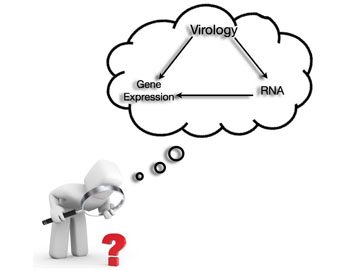
Howard Hughes Medical Institute Investigator and Professor of Molecular Therapeutics*
*and of Plant and Microbial Biology
Lab Homepage: http://glaunsingerlab.berkeley.edu/ Full Directory Information
Full Directory Information
Research Interests
We explore how viral infection reshapes the gene expression landscape of mammalian cells. This encompasses viral repurposing and altering of cellular gene regulation machinery to promote virus replication, as well as cellular responses to viral invasion. We primarily study these events using gammaherpesviruses such as Kaposi’s sarcoma-associated herpesvirus, which is a major cause of AIDS-associated cancers. Our research is revealing how virus-host interactions can have unexpected consequences for gene expression that provide insight into both virus and host biology.
Current Projects
Viruses and the Art of Gene Expression

Mechanisms & Consequences of Virus-Induced mRNA Destruction
The ability to regulate RNA stability has the potential to impact gene expression on a global scale, but is also critical for fine-tuning cellular responses to specific stimuli. We showed that gammaherpesviruses such as Kaposi’s sarcoma-associated herpesvirus encode an endonuclease termed SOX that coordinates with mammalian messenger RNA (mRNA) decay machinery to promote widespread degradation of mRNAs. SOX uses a combination of RNA sequence and structure to achieve both targeting breadth and specificity.
How do cells sense and respond to these broad changes in RNA abundance? Our recent work has shown that virus-induced mRNA cleavage and degradation triggers diverse alterations in the gene expression cascade, including differential nuclear-cytoplasmic shuttling of RNA binding proteins and global dampening of RNA polymerase II occupancy on the mammalian genome. Current projects are centered on dissecting connections between the last and the first stage of the mRNA lifecycle, as well as deciphering the biology and targeting mechanisms of viral factors that dampen host gene expression. Beyond herpesviruses, we study how functionally related proteins from a variety of viruses (including coronaviruses and poxviruses) reshape the cellular RNA landscape.
Novel Modes of Transcriptional Regulation During Infection
A universal feature of dsDNA viruses is that they all encode a class of genes whose expression is intimately linked to replication of the viral genome. These are termed ‘late genes’, and their transcription is robustly stimulated after the onset of DNA replication but otherwise restricted. Recent studies indicate that late gene transcriptional regulation in these viruses is unique, as it incorporates both molecular mimicry and selective recruitment of key host transcriptional machinery in a manner not previously observed in viral or host gene expression. In particular, one of the viral proteins required for late gene transcription directly binds both Pol II and promoter DNA, making this a unique viral transcriptional coordinator—and the first example of its kind in higher eukaryotes or eukaryotic viruses. We are currently working to understand how this hybrid virus-host preinitiation complex is assmembed and regulated. This viral model is anticipated to reveal new modes of transcriptional control, which may well have parallels in mammalian gene expression.
Viral activation and co-option of noncoding RNA
Nearly half of the mammalian genome is composed of transposable elements, which are silent—at least most of the time. However, a subset of these elements that do not encode for any proteins, termed short interspersed nuclear repeats, or SINEs, can get activated in response to viral infection. The B2 subfamily of SINEs are evolutionarily related to transfer RNAs (tRNA), which are essential for decoding mRNA into protein during translation. We found that murine gammaherpesvirus infection causes dramatic upregulation of many B2 SINE noncoding RNAs and tRNA loci. These noncoding RNAs likely engage cellular RNA processing and sensing machinery, influencing the cellular response to infection. Current projects are aimed at understanding how gammaherpesvirus infection causes selective RNA polymerase III activation of a subset of tRNAs and B2 SINEs, as well as dissecting the functional consequences of these virally induced noncoding RNAs.
Selected Publications
Hartenian E and Glaunsinger B. (2020) Herpesvirus infection reduces Pol II occupancy of host promoters but spares viral promoters.
Tucker JT, Schaller AM, Willis I and Glaunsinger B. (2020) Alteration of the premature tRNA landscape by gammaherpesvirus infection.
mBio, 2020 11:e02664-20
Mendez AS, Vogt C, Bohne J, and Glaunsinger BA. (2018) Site specific target binding controls RNA cleavage efficiency by the Kaposi’s sarcoma-associated herpesvirus endonuclease SOX.
Nucleic Acids Research, 2018 Oct 13. doi: 10.1093/nar/gky932. (bioRxiv doi: https://doi.org/10.1101/320929)
Gilbertson S, Federspiel JD, Hartenian H, Cristea IM, and Glaunsinger B. (2018) Changes in mRNA abundance drive shuttling of RNA binding proteins, linking cytoplasmic RNA degradation to transcription.
eLife 2018;7:e37663.
Muller M and Glaunsinger B. (2017) Nuclease escape elements protect messenger RNA against cleavage by multiple viral endonucleases.
PLoS Pathogens. Aug 25;13(8):e1006593.
Abernathy E, Gilbertson S, Alla R, Glaunsinger B. (2015) Viral Nucleases Induce an mRNA Degradation-Transcription Feedback Loop in Mammalian Cells.
Cell Host & Microbe. 18(2):243-53.
Karijolich J, Abernathy E, and Glaunsinger B. (2015) Infection-Induced Retrotransposon-Derived Noncoding RNAs Enhance Herpesviral Gene Expression via the NF-kB Pathway.
PLoS Pathogens; 11(11): e1005260.
Davis ZH, Verschueren E, Jang GM, Kleffman K, Johnson JR, Park J, Von Dollen J, Maher CM, Johnson T, Newton W et al.. 2015. Global mapping of herpesvirus-host protein complexes reveals a transcription strategy for late genes.
Molecular Cell. 57(2):349-60.
Photo credit: Mark Hanson at Mark Joseph Studios.
Last Updated 2021-03-24

